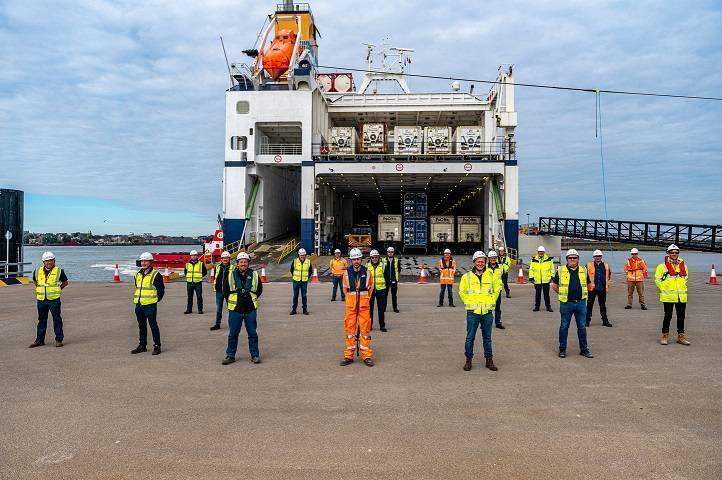Our CEO talks about creating a more resilient UK through COVID-19 recovery
Friday 19th June 2020
Our CEO talks about creating a more resilient UK through COVID-19 recovery

The coronavirus pandemic has brought the UK’s vulnerabilities to the fore. However, breakdown presents an opportunity for breakthrough to create a more resilient UK through COVID-19 recovery, writes Charles Hammond, chief executive of the Forth Ports Group.
With the end of the Brexit transition – or negotiating – period six months away, the need for purpose is clearer than ever.
Having just completed the construction of a new £250 million Brexit-ready and COVID-19 compliant freight ferry terminal – Tilbury2 – at London’s major port, the opportunities are boundless.
But in order to deliver cathartic and lasting change, we need resolute purpose from the UK government. Similar to the vision to establish the net zero commitment, the country needs a national resilience strategy.
What do I mean by this? We need a long-term strategy underpinned by in-depth analysis that examines a range of weaknesses, from the frailties of our supply chains, future skills shortages to the residual capability required to maintain critical supplies – whether medical or industrial equipment – in times of extreme need.
A realistic look at the country’s Achilles’ heel(s) in the face of a variety of headwinds, from geopolitical factors to natural disasters. All backed up by sustained action to address identified weaknesses.
Amidst the terrible human impact and long-term economic consequences of the coronavirus epidemic, one of the few upsides of the current lockdown has been an improved environment and wholesale commitment to tackling climate change, and a focus on the efficiency and resilience throughout supply chains.
Greater flexibility in the workplace through harnessing the use of technology, reducing fuel consumption and the widespread examination of commercial space will remain a focus for businesses going forward.
These issues have been well discussed, yet the resilience of complex continental-wide supply chains has received far less attention.
Whether BP or the logistics sector, there’s a growing belief that the COVID-19 pandemic will bring major changes and accelerate the transition to a lower carbon world.
Breakdown of production lines, unpredictable industrial relations and increasing pan-European lorry driver shortages have led many in the logistics industry to examine the reliability of their current delivery options.
In the coming months, the Government and freight industry have a unique opportunity to recalibrate the public policy, regulatory and fiscal system to deliver sustained investment in low carbon infrastructure that supports coastal communities.
As we approach the end of the transition period and move towards a net zero future, the effort to scrutinise the financial, human and environmental cost of moving components, goods and materials across Europe and further afield will heighten.
Is it sustainable for millions of lorries to funnel through an unpredictable pinch-point in northern France, stack up through Kent, crawl across the Thames and around the M25?
The UK’s membership of the EU single market and customs union has brought many benefits, but it has distorted the freight market.
The deep irony is that Brexit is unlikely to be the fission that delivers the lasting change that many anticipated.
With passengers largely disappearing from ferries across the North Sea, The Channel and the Irish Sea, the coronavirus epidemic has completely changed the dynamics of the logistics industry.
In the absence of a cross-subsidy from passengers to freight units, greater exposure of the true end-to-end cost of moving goods is emerging.
Combine this with the need to abate climate change, reduce road congestion, tackle poor air quality and level up the economies of the regions, the momentum for change is growing. All points identified in the UK’s latest strategy, Maritime 2050.
Unlike the borough of Thurrock – “the ports capital of the UK” – many port towns and coastal communities have turned away from the original source of their wealth, but that can change.
By bringing goods closer to the point of consumption or production, we could and should see new ferry and container shipping routes springing up. Combine this positive with the greater use of rail for inward distribution, unaccompanied freight is the answer to a number of the questions of our time.
This is the vision we have for the ports across our group at Forth Ports serving the key business and consumer markets in the South East, London and east coast of Scotland.
At ports across the country, container and ferry berth capacity exists, alongside an appetite to tackle this national challenge. In effect, reinventing the ship.
Our new feeder service from the country’s most advanced deep-sea container port, London Gateway, to Scotland’s road, rail and sea freight hub at Grangemouth is a clear demonstration of how the market is shifting.
Tranship direct from a European or UK hub port via a coastal feeder vessel – eliminating the long domestic road leg and the logistics industry’s dependency on a diminishing pool of drivers willing to transit across Europe – by utilising an unaccompanied ferry or container freight route.
Over the past decade, Department for Transport figures show a 39 per cent increase in the number of unaccompanied freight units leaving the UK to Europe.
The modal switch to unaccompanied trailers and short-sea containers will be accelerated by Brexit as this type of operation is more aligned to the requirements of new customs and associated cargo checks on arrival or departure from the UK.
The queues of lorries at Channel ports this week are testament to the fact that unaccompanied freight movements align with COVID-19 regulations, as they reduce the risk to driver-to-driver contact on ferries or train and the need for additional paperwork.
The paradigm shift for the UK is simply about moving away from a problem-based approach to a solution-based approach.
